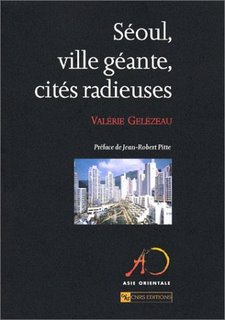(Urban space) Valérie Gelezeau about apartments
 My earlier post about the changing Seoul landscape due to apartment construction seems to have awaked quite a lot of interest (not the least due to the kind link by Mr Marmot). My earlier post about the changing Seoul landscape due to apartment construction seems to have awaked quite a lot of interest (not the least due to the kind link by Mr Marmot). The French geographer Valérie Gelezeau has made an important study on the creation of the whole apartment block system, published (unfortunately for me) in French by the name Séoul, ville géante, cités radieuses (Review by James Hoare at Korean Studies Review). There's been a short article by Yonhap on a presentation by Gelezeau from last Autumn which I've downloaded a long time ago. Putting some of it into English, I may post it here as well. What is below is not a direct translation, but rendering what was quoted from Gelezeau in the article. (Link to the article online) The normal explanation has been that the high population density has lead to the creation of apartment blocks, but large-scale apartment construction has not been the result of a lack of building land in dense population in countries such as Netherlands and Belgium. • "Charting the Cycle of Modern Housing", interview of Delezeau in Korea Herald • "Apartments make us powerless", Hankyoreh 21 weekly (log-in apparently not needed) Now, my time and resources are lacking to make a comparison with all the apartment house building here in Finland during the rapid (and in European scale late) urbanization, but the process cannot have been that different from Korea. Perhaps the difference has been that we've had the so-called hero architects who've decided what kind of living environments are suitable for people in the modern world. (Population density is almost 30 times smaller than in South Korea but the share of population living in apartments is almost as high - 43%.) Update. My own insistence on talking about apartments and charting what they mean in Korea stems from the fact that there are so few in the area that I'm talking about in my own research, and that is meaningful in defining the position of the area in the mental landscape of Seoulites and Koreans. Interestingly, my feeling is that of the Gwanak-gu areas, Bongcheon-dong used to be known as less well-off than Sillim-dong (which had its own poor hillside areas in Nan'gok and elsewhere), but now with the recent gentrification (what an authoritative word) of Bongcheon-dong through the intensive apartment-building as seen in the pictures below, the situation may have turned. But I'm not sure. Still, certain parts of Sillim-dong can bee seen as modern and developing when compared for example with Doksan-dong in Geumchon-gu, where a hairdressing shop keeper moved a few years ago. "This is countryside sigol" (she said of Doksan-dong). - How come countryside? " - Because people have been living here for a long time... There has been development in Sillim-dong, building of cramming dorms and so, and rents are higher, but this is 10 years behind in development... People throwing cigaret butts in the alleys." And finally, I want to quote a bit from the Korea Herald article "Charting the Cycle of Modern Housing" linked above: During the 1970s, multistory apartments seemed like an obvious housing solution for the droves of people moving into the city. According to the National Statistical Office, between 1960 and 1970, Seoul's population more than doubled its size, from 2.4 million to 5.5 million people, with over 50 percent of the population being recent migrants from rural areas. Update 2. Forgot to add that there's a Korean translation of Delezeau's book in preparation. Categories at del.icio.us/hunjang: books ∙ academic ∙ housing ∙ socialcategories |


